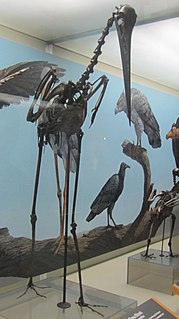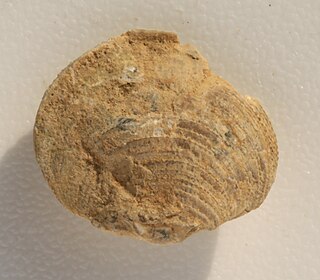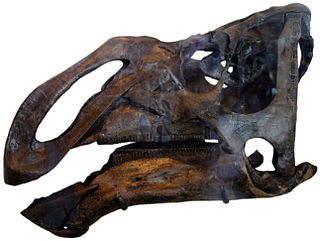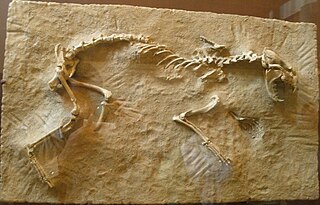 W
WAgroecomyrmex is an extinct genus of ants in the formicid subfamily Agroecomyrmecinae, for which it is the type genus. The genus contains a single described species, Agroecomyrmex duisburgi. Agroecomyrmex is known from a group of Middle Eocene fossils which were found in Europe.
 W
WAloposaurus is an extinct genus of gorgonopsian therapsids from the Late Permian of South Africa. It was first named by Robert Broom in 1910, and contains the type species A. gracilis, and possibly a second species A. tenuis. This small gorgonopsid had a slender narrow skull only 12 centimetres (4.7 in) long, with a total body length of 60–70 cm (2.0–2.3 ft). Aloposaurus is known from a single weathered skull from a probable immature individual.
 W
WAraeoscelis is an extinct genus of reptile, and one of the earliest diapsids. Fossils have been found in the Nocona, Arroyo and Waggoner Ranch Formations in Texas, dating to the Early Permian. Two species have been described, A. casei and A. gracilis.
 W
WArchiinocellia is an extinct monotypic genus of Snakefly containing the single species Archiinocellia oligoneura.
 W
WCacops, a genus of dissorophid temnospondyls, is one of the most distinctive Paleozoic amphibians that diversified in the equatorial region of Pangea during the Kungurian stage of the early Permian. Dissorophids were a group of fully terrestrial, often heavily armored faunivores. This, along with their relatively large size and geographical range suggest that they were able to coexist with amniotes as predators during the early Permian. Dissorophidae has four distinct clades differentiated largely on the morphology of the osteoderms, the Eucacopinae, the Dissorophinae, the Aspidosaurinae, and the Platyhystricinae. Cacops is one of the few olsoniforms whose ontogeny is beginning to surface. Cacops fossils were almost exclusively known from the Cacops Bone Bed of the Lower Permian Arroyo Formation of Texas for much of the 20th century. New material collected from the Dolese Brothers Quarry, near Richards Spur, Oklahoma in the past few decades has been recovered, painting a clearer picture of what the animal looked and acted like.
 W
WCiconia maltha, also known as the asphalt stork or La Brea stork, is an extinct stork from the Late Pliocene – Late Pleistocene of United States, Cuba and Bolivia. It has been found in the La Brea Tar Pits.
 W
WCleiothyridina is an extinct genus of brachiopods.
 W
WDastilbe is an extinct genus of prehistoric bony fish from the Aptian.
 W
WElectromyrmex is an extinct genus of ants in the formicid subfamily Dolichoderinae. The genus contains a single described species, Electromyrmex klebsi and is known from a group of Middle Eocene fossils which were found in Europe.
 W
WEuoplocephalus is a genus of very large, herbivorous ankylosaurian dinosaurs, living during the Late Cretaceous of Canada. It has only one named species, Euoplocephalus tutus.
 W
WGalepus is an extinct genus of anomodont therapsids.
 W
WKritosaurus is an incompletely known genus of hadrosaurid (duck-billed) dinosaur. It lived about 74.5-66 million years ago, in the Late Cretaceous of North America. The name means "separated lizard", but is often mistranslated as "noble lizard" in reference to the presumed "Roman nose".
 W
WPachyhyrax was a genus of herbivorous hyrax-grouped mammal belonging to the clade Paenungulata.
 W
WParapithecus is an extinct genus of primate that lived during the Late Eocene-Earliest Oligocene in what is now Egypt. Its members are considered to be basal anthropoids and the genus is closely related to Apidium. There are two known species. There are of appearance is about 33 million years to 40 million years.
 W
WThe Pleistocene coyote, also known as the Ice Age coyote, is an extinct subspecies of coyote that lived in western North America during the Late Pleistocene era. Most remains of the subspecies were found in southern California, though at least one was discovered in Idaho. It was part of a carnivore guild that included other canids like foxes, gray wolves, and dire wolves.
 W
WPropliopithecus is an extinct genus of primate.
 W
WSaltopus is a genus of very small bipedal dinosauriform containing the single species S. elginensis from the late Triassic period of Scotland. It is one of the most famous Elgin Reptiles.
 W
WSivapithecus is a genus of extinct apes. Fossil remains of animals now assigned to this genus, dated from 12.2 million years old in the Miocene, have been found since the 19th century in the Siwalik Hills of the Indian subcontinent as well as in Kutch. Any one of the species in this genus may have been the ancestor to the modern orangutans.
 W
WSthenictis is an extinct genus in the weasel family (mustelids) endemic to North America and Asia during the Miocene epoch living from ~15.97—5.33 Ma (AEO) existing for approximately 11 million years .